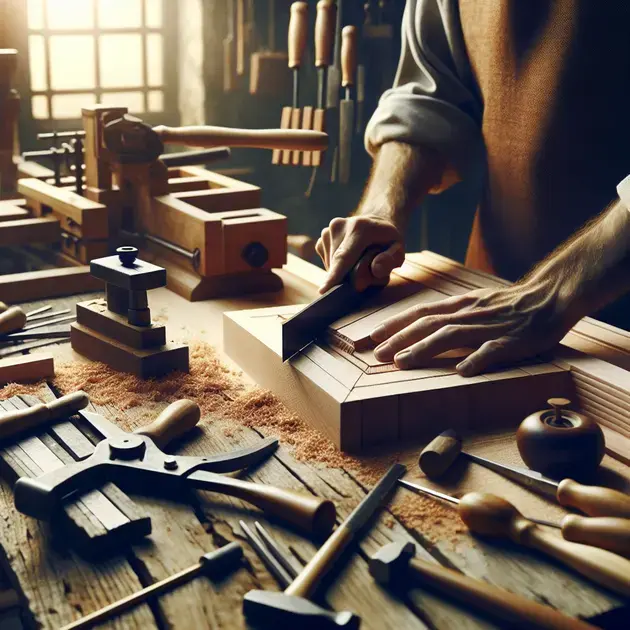Woodworking is a timeless craft that allows individuals to create beautiful and functional pieces from wood. Whether you’re a beginner or an experienced woodworker, mastering the art of woodworking requires dedication, skill, and the right techniques. In this blog post, we will explore essential tips and techniques to help you enhance your woodworking skills and create stunning projects.
One important aspect of mastering woodworking is understanding the different types of wood and their properties. Each type of wood has its own unique characteristics, such as hardness, grain pattern, and color. By learning about the different kinds of wood available and how they respond to various woodworking techniques, you can choose the best materials for your projects and achieve professional results.

Essential Woodworking Tools for Beginners
Woodworking is a fulfilling hobby that allows you to create beautiful and functional pieces with your own hands. As a beginner, it’s important to start with the right tools to ensure your projects are successful. Here are some essential woodworking tools for beginners:
1. Hammer and Mallet
A hammer and mallet are essential for driving in nails and making adjustments to your workpieces. Look for a claw hammer with a comfortable grip for added control. For delicate tasks, a rubber mallet can be useful to avoid damaging the wood.
2. Hand Saw
A hand saw is necessary for making straight and curved cuts in wood. Choose a quality hand saw with fine teeth for smoother cuts. You can find a variety of hand saws at your local hardware store or online at websites like Home Depot or Lowe’s.
3. Chisels
Chisels are versatile tools used for carving, shaping, and smoothing wood surfaces. Invest in a set of high-quality chisels with different blade widths to handle various woodworking tasks. You can purchase chisels from woodworking stores like Rockler or Woodcraft.
4. Measuring Tape
Precision is key in woodworking, so a reliable measuring tape is essential. Choose a measuring tape with clear markings and a locking mechanism to ensure accurate measurements. You can find measuring tapes at hardware stores or online on Amazon.
5. Clamps
Clamps are necessary for holding pieces of wood together while the glue dries. Invest in a variety of clamps, including bar clamps, C-clamps, and spring clamps, to accommodate different project sizes. Visit a woodworking specialty store like Woodworker’s Supply to explore clamp options.
Tips for Choosing the Right Type of Wood
Choosing the right type of wood is crucial for the success of your woodworking projects. Different woods have unique characteristics that can affect the appearance and durability of your finished piece. Here are some tips for selecting the right type of wood:
1. Consider the Project
Before choosing a type of wood, consider the specific requirements of your project. For example, if you are building outdoor furniture, you’ll need a wood species that is weather-resistant, such as cedar or teak. Research woodworking websites like Wood Magazine or Fine Woodworking for project-specific wood recommendations.
2. Understand Wood Grain
Wood grain refers to the direction of wood fibers in a piece of lumber. Pay attention to the grain pattern when selecting wood for your project, as it can affect the strength and appearance of the finished piece. Websites like The Wood Database offer detailed information on different wood species and their grain patterns.
3. Choose Hardwood or Softwood
Wood is categorized as either hardwood or softwood based on its botanical classification, not its hardness. Hardwoods like oak and maple are known for their durability and beauty, making them ideal for furniture and decorative pieces. Softwoods like pine and cedar are often used for framing and construction projects. Check out lumberyards like Lumber Liquidators or Woodworkers Source for a variety of hardwood and softwood options.
4. Consider Sustainability
When selecting wood for your projects, consider the environmental impact of your choice. Look for wood that is sourced from sustainable forests or certified by organizations like the Forest Stewardship Council (FSC). Sustainable wood options can be found at eco-conscious suppliers like EcoTimber or Green Building Supply.
5. Test Samples
If you’re unsure about which type of wood to use, consider testing samples before starting your project. Purchase small pieces of different wood species and experiment with them to see how they respond to cutting, sanding, and finishing. This hands-on approach can help you choose the best wood for your specific needs.
Mastering Woodworking Techniques for Professional Results
Mastering woodworking techniques is essential for achieving professional results in your projects. Whether you’re a beginner or experienced woodworker, honing your skills will enhance the quality of your work. Here are some tips for mastering woodworking techniques:
1. Practice Basic Joinery
Joinery techniques like dovetail joints, mortise and tenon joints, and dado joints are fundamental to woodworking. Practice these basic joinery methods using scrap wood or practice pieces to improve your skills. Online platforms like YouTube or Woodworkers Guild of America offer tutorials on woodworking joinery.
2. Learn Proper Sanding Techniques
Sanding is a crucial step in woodworking that can greatly affect the final appearance of your project. Learn proper sanding techniques, such as using progressively finer grit sandpaper and sanding with the grain of the wood, to achieve smooth and professional results. Websites like Woodworker’s Journal provide articles and videos on woodworking sanding tips.
3. Invest in Quality Tools
Quality woodworking tools can make a significant difference in the outcome of your projects. Invest in high-quality tools like chisels, planes, and hand saws to improve the precision and efficiency of your work. Consider reputable woodworking tool brands like Festool or Lie-Nielsen for superior craftsmanship.
4. Attend Workshops and Classes
Enhance your woodworking skills by attending workshops, classes, or seminars led by experienced woodworkers. Learning from professionals in a hands-on setting can help you gain valuable insights and techniques to elevate your woodworking craftsmanship. Check local woodworking schools or events like The Woodworking Shows for educational opportunities.
5. Experiment with Different Finishes
The choice of finish can greatly impact the appearance and longevity of your woodworking projects. Experiment with different finishes, such as stains, varnishes, or oils, on scrap wood samples to see how they interact with different wood species. Websites like Popular Woodworking offer articles and guides on woodworking finishes and application techniques.

Practical Tips for Creating Stunning Wood Furniture
When it comes to creating stunning wood furniture, there are several practical tips that can help you achieve a professional and high-quality result. One essential tip is to choose the right type of wood for your project. Selecting high-quality wood, such as mahogany or oak, can significantly impact the final look and durability of your furniture piece.
Another crucial tip is to pay attention to detail during the design and planning phase. Taking accurate measurements and creating detailed sketches can help you avoid costly mistakes during the construction process. Additionally, using high-quality tools and equipment is vital for achieving precision and accuracy in your woodworking projects.
Furthermore, don’t underestimate the importance of sanding and finishing your wood furniture properly. A smooth and well-finished surface can elevate the overall look of your piece and enhance its longevity. Experimenting with different wood stains and finishes can also add a unique touch to your furniture, making it stand out.
Lastly, always strive for continuous improvement in your woodworking skills. Learning new techniques, attending workshops, and seeking inspiration from other woodworkers can help you elevate your craft and create truly stunning wood furniture pieces that stand the test of time.
Exploring Different Woodworking Finishes
Exploring different woodworking finishes is a crucial aspect of creating beautiful and long-lasting wood furniture pieces. One popular finish that can enhance the natural beauty of wood is the use of oils. Applying oils such as tung oil or linseed oil can bring out the rich colors and textures of the wood, giving it a warm and lustrous appearance.
Another common woodworking finish is the use of varnishes or lacquers. These finishes provide a protective layer that can help prevent damage from moisture and everyday wear and tear. Varnishes come in various sheens, from matte to high gloss, allowing you to customize the look of your furniture piece.
For a more rustic and natural look, consider using wax finishes. Waxes provide a soft and subtle sheen to the wood while also offering some level of protection. They are easy to apply and can be buffed to a smooth finish, adding a touch of elegance to your furniture.
Experimenting with different finishes and techniques can help you discover the perfect combination that enhances the beauty of the wood while also providing the necessary protection for your furniture piece. Remember to test the finishes on a small, inconspicuous area before applying them to the entire piece to ensure the desired result.
Improving Precision in Woodworking Projects
Improving precision in woodworking projects is essential for achieving professional and high-quality results. One fundamental step in enhancing precision is to invest in high-quality measuring tools, such as calipers and squares. Accurate measurements are crucial for ensuring that all components fit together seamlessly and that the final piece is structurally sound.
Additionally, paying attention to detail during the cutting and shaping of wood is crucial for precision. Using sharp and well-maintained cutting tools, such as chisels and saws, can help you achieve clean and precise cuts. Taking your time and double-checking measurements before making any cuts can prevent costly errors.
Furthermore, honing your woodworking skills through practice and continuous learning can significantly improve your precision. Attending woodworking classes, watching tutorial videos, and seeking guidance from experienced woodworkers can provide valuable insights and techniques to help you enhance your precision in woodworking projects.
Lastly, maintaining a clean and organized workspace can also contribute to improved precision in woodworking. Having a clutter-free environment and a well-organized tool setup can help you work more efficiently and accurately, ultimately leading to better results in your woodworking projects.
Conclusion
In conclusion, creating stunning wood furniture requires attention to detail, quality materials, and continuous improvement in woodworking skills. Choosing the right type of wood, such as mahogany or oak, can greatly impact the final look and durability of your furniture piece. Paying meticulous attention during the design phase, using high-quality tools, and properly sanding and finishing the wood are essential steps to elevate the overall appearance and longevity of your furniture.
Exploring different woodworking finishes, such as oils, varnishes, and waxes, can further enhance the natural beauty of the wood while providing protection against wear and tear. Experimenting with various finishes and techniques allows you to customize the look of your furniture piece and find the perfect combination that enhances both aesthetics and durability.
Improving precision in woodworking projects is key to achieving professional results. Investing in high-quality measuring tools, focusing on detail during cutting and shaping, honing woodworking skills through practice and learning, and maintaining a clean workspace are crucial for enhancing precision and ensuring the structural integrity of your creations. By following these practical tips and techniques, you can create truly stunning wood furniture pieces that stand the test of time.